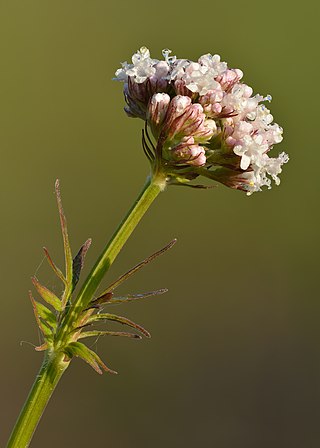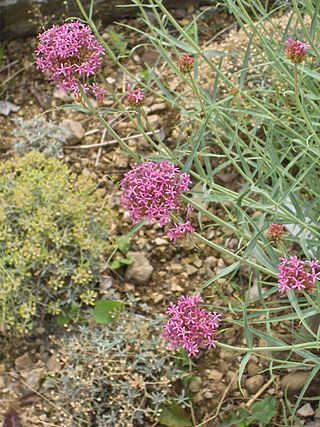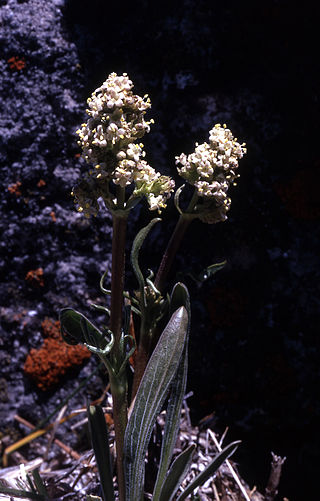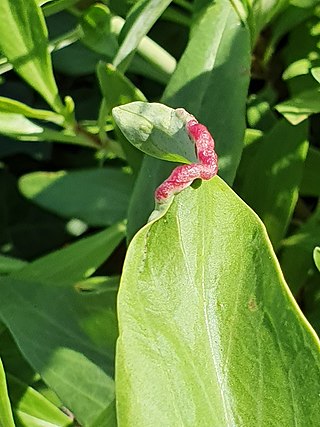
The Dipsacales are an order of flowering plants, included within the asterid group of dicotyledons. In the APG III system of 2009, the order includes only two families, Adoxaceae and a broadly defined Caprifoliaceae. Some well-known members of the Dipsacales order are honeysuckle, elder, viburnum, and valerian.

The Malpighiales comprise one of the largest orders of flowering plants, containing about 36 families and more than 16,000 species, about 7.8% of the eudicots. The order is very diverse, containing plants as different as the willow, violet, poinsettia, manchineel, rafflesia and coca plant, and are hard to recognize except with molecular phylogenetic evidence. It is not part of any of the classification systems based only on plant morphology. Molecular clock calculations estimate the origin of stem group Malpighiales at around 100 million years ago (Mya) and the origin of crown group Malpighiales at about 90 Mya.

Rosales is an order of flowering plants. It is sister to a clade consisting of Fagales and Cucurbitales. It contains about 7,700 species, distributed into about 260 genera. Rosales comprise nine families, the type family being the rose family, Rosaceae. The largest of these families are Rosaceae (91/4828) and Urticaceae (53/2625). The order Rosales is divided into three clades that have never been assigned a taxonomic rank. The basal clade consists of the family Rosaceae; another clade consists of four families, including Rhamnaceae; and the third clade consists of the four urticalean families.

Valerian is a perennial flowering plant native to Europe and Asia. In the summer when the mature plant may have a height of 1.5 metres, it bears sweetly scented pink or white flowers that attract many fly species, especially hoverflies of the genus Eristalis. It is consumed as food by the larvae of some Lepidoptera species, including the grey pug.

The Caprifoliaceae or honeysuckle family is a clade of dicotyledonous flowering plants consisting of about 860 species, in 33, to 42 genera, with a nearly cosmopolitan distribution. Centres of diversity are found in eastern North America and eastern Asia, while they are absent in tropical and southern Africa.

The Celastrales are an order of flowering plants found throughout the tropics and subtropics, with only a few species extending far into the temperate regions. The 1200 to 1350 species are in about 100 genera. All but seven of these genera are in the large family Celastraceae. Until recently, the composition of the order and its division into families varied greatly from one author to another.

The family Campanulaceae, of the order Asterales, contains nearly 2400 species in 84 genera of herbaceous plants, shrubs, and rarely small trees, often with milky sap. Among them are several familiar garden plants belonging to the genera Campanula (bellflower), Lobelia, and Platycodon (balloonflower). Campanula rapunculus and Codonopsis lanceolata are eaten as vegetables. Lobelia inflata, L. siphilitica and L. tupa and others have been used as medicinal plants. Campanula rapunculoides may be a troublesome weed, particularly in gardens, while Legousia spp. may occur in arable fields.

Centranthus is a flowering plant genus comprising herbs and subshrubs native to Southern Europe. It is in the family Caprifoliaceae. There are about twelve species in the genus. Some Centranthus are known as introduced species in other parts of the world, including Centranthus ruber in the western United States and Centranthus macrosiphon in Western Australia.

Centranthus ruber, the red valerian, spur valerian, kiss-me-quick, fox's brush, devil's beard or Jupiter's beard, is a popular garden plant grown for its ornamental flowers.

The eudicots, Eudicotidae, or eudicotyledons are a clade of flowering plants (angiosperms) which are mainly characterized by having two seed leaves (cotyledons) upon germination. The term derives from dicotyledon. Previously, they were called tricolpates or non-magnoliid dicots by past authors. The current botanical terms were introduced in 1991, by evolutionary botanist James A. Doyle and paleobotanist Carol L. Hotton, to emphasize the later evolutionary divergence of tricolpate dicots from earlier, less specialized, dicots.

Peridiscaceae is a family of flowering plants in the order Saxifragales. Four genera comprise this family: Medusandra, Soyauxia, Peridiscus, and Whittonia., with a total of 12 known species. It has a disjunct distribution, with Peridiscus occurring in Venezuela and northern Brazil, Whittonia in Guyana, Medusandra in Cameroon, and Soyauxia in tropical West Africa. Whittonia is possibly extinct, being known from only one specimen collected below Kaieteur Falls in Guyana. In 2006, archeologists attempted to rediscover it, however, it proved unsuccessful.

Mesangiospermae is a clade of flowering plants (angiosperms), informally called "mesangiosperms". They are one of two main groups of angiosperms. It is a name created under the rules of the PhyloCode system of phylogenetic nomenclature. There are about 350,000 species of mesangiosperms. The mesangiosperms contain about 99.95% of the flowering plants, assuming that there are about 175 species not in this group and about 350,000 that are. While such a clade with a similar circumscription exists in the APG III system, it was not given a name.

Valeriana jatamansi, formerly known as Valeriana wallichii, is a rhizome herb of the genus Valeriana and the family Valerianaceae also called Indian Valerian or Tagar-Ganthoda, not to be confused with ganthoda, the root of Indian long pepper. It is an herb useful in Ayurvedic medicine used as an analeptic, antispasmodic, carminative, sedative, stimulant, stomachic, and nervine.

Valeriana edulis, the tobacco root or edible valerian, a species of flowering plant in the family Caprifoliaceae, is a dioecious perennial herb native to western and central North America. Despite its common name, tobacco root is not closely related to tobacco, but is instead more closely related to elderberry, honeysuckle, and teasel.

Valeriana pauciflora, commonly called the largeflower valerian, is a flowering plant species in the family Caprifoliaceae. It is native to the Eastern United States, where it is found in the regions of the Interior Low Plateau, the Ohio River drainage, and the Potomac River Valley. In this region, it is found in very nutrient-rich, mesic forest communities, often in stream valleys or lower slopes.

Valerianoideae is a subfamily of plants.

Trioza centranthi is a sap-sucking hemipteran bug in the family Triozidae which creates galls on the leaves and flowers of Centranthus and Valerianella species. It was first described by Jean Nicolas Vallot, a French entomologist in 1829 and is found in Europe.

Valerianella umbilicata, is a synonym for Valeriana umbilicata known by the common name navel cornsalad. It is a dicot, annual plant in the flowering plant family Caprifoliaceae. It is native to the Eastern North America and some parts of Canada and has no known uses other than being edible.

















